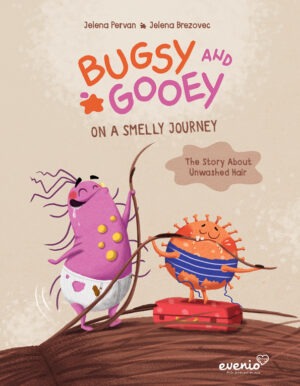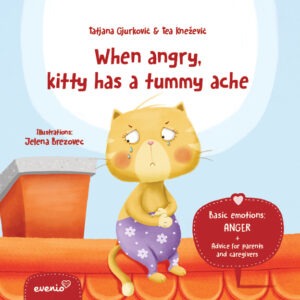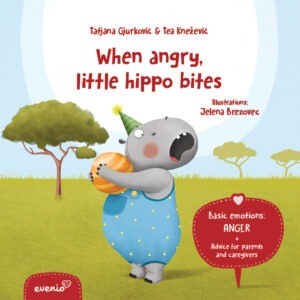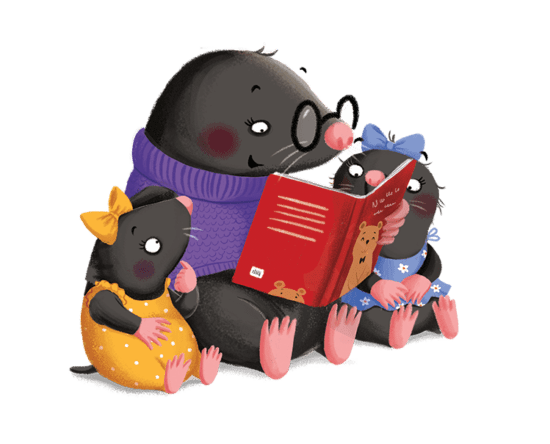When angry, bunny hurts himself
Basic emotions: ANGER
| Author | Tatjana Gjurković, Tea Knežević |
|---|---|
| Illustrator | Jelena Brezovec |
| Original Title | Kad je ljut, zeko se ozljeđuje |
| ISBN | 978-953-8008-68-9 |
| Format | softcover |
| Pages | 24 |
| Size | 22x22 cm |
| Age range | Early learning (2 – 6), Beginning readers (5 – 7) |
Get in touch
We can’t wait to explore new opportunities together!
| Category | Anger |
|---|---|
| Tag | Basic emotions: ANGER |
WRITTEN BY EXPERTS IN CHILD PSYCHOLOGY
Little rabbit lived on a big farm full of animals. One day he was looking for someone to play with, but all his friends seemed to be already in the middle of a game or wanted to play alone. Rabbit was persistent, but it turned out that everyone rejected him that day. He felt disappointed and sad, and very soon he was overwhelmed with so much anger that he hit a tree with his paw and hurt himself. Fortunately, a wise owl saw everything and helped the bunny cope with unpleasant emotion of anger in a way that doesn’t hurt him or anyone else around him.
This story is part of therapeutic picture book series about anger in children. It deals with the problem of expressing anger through auto-aggressive behaviour or self-harm.
Anger belongs to so-called – basic emotions. Basic emotions appear in all cultures and can be seen in babies from birth. By the end of the 6th month of life, child expresses all four basic emotions (anger, fear, happiness and sadness).
Anger is an emotion extremely focused on others, it can be very strong and intense, and it seeks to be expressed “outwardly”. It manifests itself through changes in the body which encourage tension and more impulsive behaviors. As it is much easier to notice a child’s behavior than his emotions, adults are often not aware that behind unwanted behavior are a child’s unfulfilled emotional needs.
Very often, children don’t know how to recognize and process feelings of anger or frustration, which results in aggressive behaviour. Some children will turn the aggressive behavior towards themselves. They will intentionally injure themselves. For example, a child can hit his head with his hands, pull his hair, bite himself, hit his head on the floor or wall. In a milder form, auto-aggression manifests itself as nail biting or pinching and scratching oneself. In that situation, adults should send two important messages to the child: it is okay to feel angry, but it is not okay to behave aggressively towards yourself.
The story helps children to recognize and name their own emotions, work through stressful situations and satisfy the need behind the emotion of anger.
Book also contains guidelines and advice for parents and caretakers that will help them better understand child’s behaviour, teach him to manage his behaviour and self-regulate unpleasant emotions.

Author: Tatjana Gjurković
Tatjana Gjurković has a master’s degree in psychology, she is certified psychotherapist, certified child play therapist (RPT), Certified Transactional Analyst (CTA), Teacher and Supervisor of Transactional Analysis (TSTA). She works individually with children and adults and holds educational programs for specialists in fields of child play therapy and transaction analysis. She is author of a book “Play Therapy with children” and 28 therapeutic picture books. She continuously promotes the importance of mental health in children and adults through Centar Proventus which she co-founded with her colleague Tea Knežević.

Author: Tea Knežević
Tea Knežević has master’s degree in psychology, she is certified psychotherapist, certified child play therapist (RPT) and Certified Transactional Analyst (CTA). She provides play therapy with children, psychotherapy with adults, parent consultations, and conducts numerous training courses for professionals in Centar Proventus which she co-founded with her colleague Tatjana Gjurković. She has written 28 picture books with therapeutic stories for children. In addition, she is the author of several manuals related to psychological resilience, gifted children, and anger management.

Illustrator: Jelena Brezovec
Jelena Brezovec has a master’s degree in social studies. For a long time, drawing was just a hobby, until 2008 when she became a co-founder of the publishing house Evenio and decided to study digital illustration, with the focus on children’s illustration. So far, she has illustrated more than 40 picture books and many other publications. She is the winner of the Grigor Vitez “Bird” Award, a special praise from the children’s jury. She has illustrated the most popular children’s book series in Croatia – Mrljek & Prljek. Her illustrations have been part of many exhibitions throughout Croatia. She lives and works in Varaždin, Croatia.







